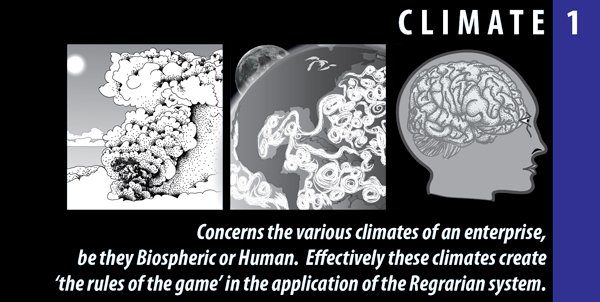HOLISTIC REGENERATION - The Regrarians® Platform - Part 1 #Climate
…The climate of the human mind is just as, if not more difficult to change than the climate of the biosphere!!.. ~Darren Doherty
When was the last time you asked someone what it is that gets them up in the morning? Is this part of our regular discussion? Are we taking the time we ought to really know the people in our lives, in general, not to mention clients?
Without doubt, the most important climate for any property is between the landowner's ears. While grasping the climate context of a property deals with many aspects of the land we’re dealing with, until we understand what the personal climate of the landowner is, whether it's us or someone we're advising, we cannot clearly understand the best design. In fact, in the case of advising, we often cannot even find out whether or not we ought to help them.
What makes the landowner tick? Why does s/he do what s/he does? What’s their philosophical approach? What are their priorities? If it's not you, what compelled them to contact you in the first place?
You may be reading this from the perspective of the landowner. Before you spend time on the actual design, it's good to go through a thorough self-assessment in an attempt to rightly discern your own cognitive climate.
When we approach our design with these considerations in mind, something changes. We begin to become more vested in, not just the the land (the contract, etc), but everyone involved. And, let’s be honest, we can’t really do nearly as good of a job at any task when we fail to know and understand the people involved.Just Do It Don't Just Do Something, Stand There
Perhaps we’ve become too focused on just getting stuff done. Maybe, in our efforts for high profits and efficiency, we’ve erased the human relationship too readily. Is it possible that we’ve sacrificed much of the core of what makes us human for more numbers to the left of the decimal point? And isn’t such thinking fallacious anyway? It certainly isn’t holistic. It isn’t healthy. And, in the end, it becomes destructive for both the land and relationships.
There is a contrast in the world between those who strive hard to just get things done and those who enjoy the experience of doing. For the former group, it’s about hustle and bustle so they can move on to the next thing. They might do a great job, but they can miss the blessing that comes in the doing. For the latter, it’s about the process, the joy of the work, doing things exceptionally and the art of their efforts. It’s not that they’re laggards, but that they are not so caught up in finishing that they fail to reap the blessing that comes in the doing. There’s a time for either one, but is that time when we’re entering into what is supposed to be a holistic relationship of stewardship?If We're Not About People, Then What's the Point?
Where else can we apply the concept of needing to understand people better? In holistic consulting, the people should be at the top of the list. But what about in our other relationships and/or jobs? What if we work at the grocery store or an office building? Would we perhaps find greater fulfillment and enjoyment in a job if we just slowed down enough to ask people what makes them tick?
This seems so important and yet so neglected. Yes, we need to focus on the other aspects of the climate of the property. The meteorological climate matters. The biological climate is a huge issue. But if we fail to approach, examine and nurture the human climate well, can we truly succeed? Can such an approach possibly be considered holistic or regenerative?
Don't Let Aesthetic Structure Overrule Holistic Design
When one is given the opportunity to sit under the teaching of a master such as Darren, what are the first things that come to mind? For me, it’s keyline, contour, swales, trees, fences, buildings, etc. I’m ready to get into GPS, topography, laser levels, keyline plows and earthworks in order to move the regeneration process along as soon as possible. This is what gets many of us fired up, right?
If you can relate, you’re not alone. As we approach our first topic of the Regrarians Platform, climate, this is exactly how a large percentage of landowners respond. They want to get the fences built, trees planted and see the structure right off the bat. This is what excites them.But, as with any significant structure, the foundation must be solid in order for the structure to stand the test of time. Darren shared that with those who were able to convince him to move on to these structural changes in the beginning of their restorative effort, they inevitably called later, regretting their haste and expressing their understanding that climate needed to be foundational. Sometimes the emotional challenge faced in such circumstances can be overwhelming.
Climate Includes Every External Influence
When we hear about climate, our minds immediately go to weather patterns. Besides the mental climate, the financial climate is a key also. This includes not only revenue from various enterprises, but debt, fixed expenses, variable operating and maintenance/repair expenses.
Ecological expenses can sometimes be hidden, ignored or even swept under the rug because of personal/emotional reasons. Yet this is a vital consideration when assessing the climate of the property.
Also considered is the bureaucratic climate. What are the zoning limits, use constraints, environmental concerns, etc.?
Each one of these climates represents an enterprise on the land that must be managed. Some more directly generate income. Others must be managed by necessity, representing an opportunity to maximize profitability today, avoid detrimental ramifications later and possibly provide insights and possibilities that would not otherwise manifest without proper attention and management.Of course, then there is the climate as it relates to weather systems. Some plants will grow in one region, yet not in another. And the reasons vary. Two places with identical weather patterns might not grow the same plants, or might not grow them as well, because of other factors such as soil, orientation, wind direction, etc. This can almost always be mitigated by influencing microclimates, but may or may not be a worthy pursuit.
Ask the Right Questions
There is no single right way to go about this. Each context is different. And sometimes a given approach works for one person while another works for the next. The point is to approach the challenge from a holistic perspective and begin with the foundation that will make the rest of the decision making as complementary as possible. Some good questions to ask include:
Decision Makers
- Primary (veto power - owner, investor, bureaucrat, significant involvement...)
- Secondary (family, tenants, bureaucrat...)
- Tertiary
- Disabilities
- Allergies
- Other
Resource Base
- Land
- Plants
- Animals
People and Organisations of Influence
- Local/state/national
- Environmental
- HOA or other
Physical Resources
- Land
- Permanent fixtures (wells, ponds, etc. will be in the water section, but could be considered here in a preliminary fashion, especially if there are relationships involved)
Financial Resources
- Stored (liquid, semi-liquid)
- Income
Quality of Life
- What gets you out of bed?
- What makes a good life?
Meteorological
- Solar access
- Day degrees & chill hours
- Precipitation (seasonal, dew, snow, rainfall)
- Wind
Feel free to contact me if you desire to discuss your project. If you're interested in hiring Darren, you can find details here.
Steemin' on,
Another Joe
- All Points Land Design
- Owning the Earth: The Transforming History of Land Ownership
- Coalition for a Propserous America
- The E-Myth Revisited: Why Most Small Businesses Don't Work and What to Do About It
- The Farming Ladder
- The Marvelous Pigness of Pigs: Respecting and Caring for All God's Creation
- World Maps of KÖPPEN-GEIGER Climate Classification
- CoCoRaHS
~ Introduction ~

Logo courtesy of @oecp85










So true, you got to think about the whole process before you even start. I say this to people all the time, I want to do it once so I want to do it the right way. This usually requires thinking and research before the first physical thing gets done.
If you don't start from the bottom up, you end up having to redo it sooner rather than later.
upvoted!
nice post